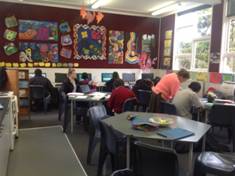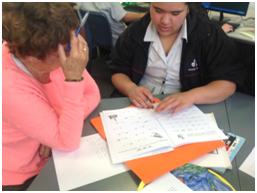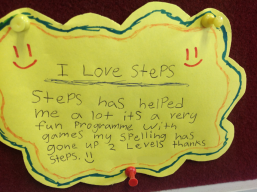Report from Chrissy Jones-Major, SENCO

We used the individual programme on a 1:1 basis with students who had significant learning disabilities and found that the students loved the highly structured, multi- sensory qualities of the programme. With booklets and computer reinforcement of skills in fun ways with medals as rewards, it was a hit.
In 2013 we were offered part funding from the RTLB Service to set up STEPS in our Learning Support Centre. We discussed the idea with our own Staff and other professionals and decided to set up a bank of six computers in our area and apply for the STEPS programme for the beginning of 2014.
We purchased new screens, headphones and computers and we were away.

The students come out of classes twice per week for one hour and as our timetable is a revolving six day time table they come at different times over the week out of different subjects. They can be mixed year levels and two teacher aides along with the SENCO supervise the STEPS group along with managing other students who are referred to Learning Support for help with their subjects.
We select the students for the STEPS Programme by looking at their PAT scores after they have been tested in March, collecting anecdotal information from teachers about students once they have settled down at the beginning of the year. What Staff have noticed about their students? Sometimes there are significant discrepancies between test results and students output and focus in classes. We chose two periods per week to work with our students as that is what the programme suggests. Students with higher needs come in and do STEPS more often, three times per week.

One of my teacher aides is really proficient at running STEPS and so she enrols the selected students on the programme and does the Schonell pre-test, prints off two copies, one for the student and one for our records. She goes through the spelling test with the student looking at where the problems lie and then we have a discussion as to what workbook level we start with. Sometimes we might go down a level depending on the maturity of the student as the higher level booklets have quite sophisticated adult language in them.
We use the comprehension, word searches and reading material provided on STEPS e.g. Volcanoes, The Pacific with students on higher level books. We also make our own material which the students can access to use on the STEPS Programme by using short stories, items from school journals, high interest reports, and core subject topics. You can enter the key words and produce vocabulary lists for understanding not spelling tests, word finds, and sentences which they can access on the STEPS computer programme. It is constant reinforcement of what the students are doing in class. We are only just scratching the surface of the ways in which we can use STEPS.
We have around fifty four students accessing STEPS across the year levels from Year 9 to Year 12, most of our students are obviously in the junior school. We do not use it with whole classes and some of our students have no particular literacy difficulties but we use it to focus them into good work habits, good behaviour and how to remain focused enjoying learning new skills without being distracted.
|
Year Group |
Number of pupils |
Average gain in 5 months – Spelling Age |
|
Year 9 |
24 |
10.3 months |
|
Year 10 |
12 |
10.1 months |
|
Year 11 |
5 |
7.6 months |
|
Year 12 |
4 |
17.5 months |
The pupils below had a maximum of 5 months on the programme. Most had approximately 5 months, but some had only recently been enrolled on the programme. The majority of students had 2 x 60 minutes per week, but some of the higher learning needs children had 3 x 60 minutes.
| Year 9 Students | ||||
|
Student |
Pre-Test |
Post-Test |
Progress |
Comments |
|
A |
9.8 |
10.2 |
6 months |
ESOL |
|
B |
12.7 |
14.1 |
18 months |
|
|
C |
12.5 |
12.9 |
4 months |
|
|
D |
8.9 |
9.1 |
4 months |
Deaf |
|
E |
7.9 |
8 |
3 months |
Truancy |
|
F |
8.2 |
9.1 |
11 months |
HLN |
|
G |
8.5 |
9.6 |
13 months |
|
|
H |
7.5 |
7.9 |
4 months |
Dyslexic |
|
I |
8.6 |
9.4 |
10 months |
|
|
J |
13.2 |
13.7 |
5 months |
|
|
K |
12.2 |
12.5 |
3 months |
|
|
L |
11.2 |
11.5 |
3 months |
|
|
M |
12 |
12.6 |
6 months |
|
|
N |
10.5 |
10.9 |
4 months |
|
|
O |
11.3 |
12.6 |
15 months |
|
|
P |
10.4 |
11.3 |
11 months |
|
|
Q |
8.6 |
13.7 |
61 months |
|
|
R |
9.4 |
9.8 |
4 months |
|
|
S |
10.2 |
12.3 |
25 months |
|
|
T |
12.1 |
12.4 |
3 months |
Deaf |
|
U |
8.7 |
8.8 |
1 month |
HLN |
|
V |
9.8 |
11.5 |
21 months |
|
|
W |
9.3 |
9.9 |
6 months |
|
|
X |
10.4 |
10.7 |
3 months |
|
|
Average Gain in 5 months |
10.3 months |
|||
| Year 10 Students | ||||
|
Student |
Pre-Test |
Post-Test |
Progress |
Comments |
|
A |
8.9 |
9.3 |
6 months |
|
|
B |
8.4 |
9.5 |
13 months |
Dyslexic |
|
C |
7.3 |
7.9 |
6 months |
|
|
D |
12.1 |
12.7 |
9 months |
|
|
E |
11.4 |
12.1 |
17 months |
|
|
F |
10.2 |
11.7 |
19 months |
|
|
G |
11.8 |
13.4 |
6 months |
|
|
H |
11.9 |
12.3 |
6 months |
|
|
I |
9.7 |
10.1 |
6 months |
|
|
J |
7.6 |
9.7 |
23 months |
|
|
K |
6.2 |
6.5 |
3 months |
|
|
L |
7.6 |
8.2 |
8 months |
HLN |
| Average Gain in 5 months | 10.1 months | |||
| Year 11 Students | ||||
|
Pre-Test |
Post-Test |
Progress |
Comments |
|
|
A |
9.7 |
10.4 |
9 months |
dyslexic |
|
B |
10.5 |
11.1 |
8 months |
|
|
C |
9.2 |
10.2 |
12 months |
HLN |
|
D |
10 |
10.4 |
4 months |
|
|
E |
10.9 |
11.2 |
5 months |
|
| Average Gain in 5 months | 7.6 months | |||
| Year 12 Students | ||||
|
Student |
Pre-Test |
Post-Test |
Progress |
Comments |
|
A |
9.2 |
10.8 |
18 months |
HLN |
|
B |
7.6 |
8.1 |
7 months |
HLN |
|
C |
12.5 |
12.6 |
1 month |
HLN |
|
D |
9.4 |
13 |
44 months |
HLN |
| Average Gain in 5 months | 17.5 months | |||